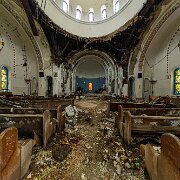
1 Saints Constantine and Helen Greek Orthodox Church in Detroit was born out of the spiritual and cultural needs of a burgeoning Greek immigrant community on the city’s west side. Beginning in the late 1920s with prayer gatherings in a rented Myrtle Street hall, the congregation officially formed in 1930 and worshipped in various makeshift spaces until purchasing land on Oakman Boulevard in 1944. Designed by Arthur Greig Jr., the structure was erected post‑World War II: the cornerstone was laid in 1948, and the first service under its signature partially complete dome took place on Palm Sunday, 1950
A striking example of mid‑20th‑century American Byzantine‑inspired Orthodox architecture, the brick‑and‑stone church features twin domed towers and a central green‐tiled dome that symbolically unites earth and heaven in Orthodox tradition . Interiors would have included classic elements such as an iconostasis separating nave and sanctuary, richly painted icons, and a raised altar area . The community thrived into the 1960s–70s, supporting a school wing and cultural center by 1960, but demographic shifts prompted relocation; by 1986, the parish moved to Westland, where a new sanctuary incorporating the original altar and iconography was completed in 1996
Along its journey from immigrant beginnings to Byzantine‑style landmark, Saints Constantine and Helen has stood as both a spiritual haven and architectural beacon for Detroit’s Greek‑Orthodox faithful.
A striking example of mid‑20th‑century American Byzantine‑inspired Orthodox architecture, the brick‑and‑stone church features twin domed towers and a central green‐tiled dome that symbolically unites earth and heaven in Orthodox tradition . Interiors would have included classic elements such as an iconostasis separating nave and sanctuary, richly painted icons, and a raised altar area . The community thrived into the 1960s–70s, supporting a school wing and cultural center by 1960, but demographic shifts prompted relocation; by 1986, the parish moved to Westland, where a new sanctuary incorporating the original altar and iconography was completed in 1996
Along its journey from immigrant beginnings to Byzantine‑style landmark, Saints Constantine and Helen has stood as both a spiritual haven and architectural beacon for Detroit’s Greek‑Orthodox faithful.
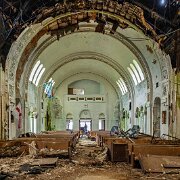
2 Saints Constantine and Helen Greek Orthodox Church in Detroit was born out of the spiritual and cultural needs of a burgeoning Greek immigrant community on the city’s west side. Beginning in the late 1920s with prayer gatherings in a rented Myrtle Street hall, the congregation officially formed in 1930 and worshipped in various makeshift spaces until purchasing land on Oakman Boulevard in 1944. Designed by Arthur Greig Jr., the structure was erected post‑World War II: the cornerstone was laid in 1948, and the first service under its signature partially complete dome took place on Palm Sunday, 1950
A striking example of mid‑20th‑century American Byzantine‑inspired Orthodox architecture, the brick‑and‑stone church features twin domed towers and a central green‐tiled dome that symbolically unites earth and heaven in Orthodox tradition . Interiors would have included classic elements such as an iconostasis separating nave and sanctuary, richly painted icons, and a raised altar area . The community thrived into the 1960s–70s, supporting a school wing and cultural center by 1960, but demographic shifts prompted relocation; by 1986, the parish moved to Westland, where a new sanctuary incorporating the original altar and iconography was completed in 1996
Along its journey from immigrant beginnings to Byzantine‑style landmark, Saints Constantine and Helen has stood as both a spiritual haven and architectural beacon for Detroit’s Greek‑Orthodox faithful.
A striking example of mid‑20th‑century American Byzantine‑inspired Orthodox architecture, the brick‑and‑stone church features twin domed towers and a central green‐tiled dome that symbolically unites earth and heaven in Orthodox tradition . Interiors would have included classic elements such as an iconostasis separating nave and sanctuary, richly painted icons, and a raised altar area . The community thrived into the 1960s–70s, supporting a school wing and cultural center by 1960, but demographic shifts prompted relocation; by 1986, the parish moved to Westland, where a new sanctuary incorporating the original altar and iconography was completed in 1996
Along its journey from immigrant beginnings to Byzantine‑style landmark, Saints Constantine and Helen has stood as both a spiritual haven and architectural beacon for Detroit’s Greek‑Orthodox faithful.
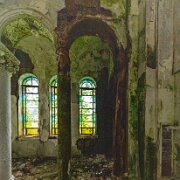
3 Saints Constantine and Helen Greek Orthodox Church in Detroit was born out of the spiritual and cultural needs of a burgeoning Greek immigrant community on the city’s west side. Beginning in the late 1920s with prayer gatherings in a rented Myrtle Street hall, the congregation officially formed in 1930 and worshipped in various makeshift spaces until purchasing land on Oakman Boulevard in 1944. Designed by Arthur Greig Jr., the structure was erected post‑World War II: the cornerstone was laid in 1948, and the first service under its signature partially complete dome took place on Palm Sunday, 1950
A striking example of mid‑20th‑century American Byzantine‑inspired Orthodox architecture, the brick‑and‑stone church features twin domed towers and a central green‐tiled dome that symbolically unites earth and heaven in Orthodox tradition . Interiors would have included classic elements such as an iconostasis separating nave and sanctuary, richly painted icons, and a raised altar area . The community thrived into the 1960s–70s, supporting a school wing and cultural center by 1960, but demographic shifts prompted relocation; by 1986, the parish moved to Westland, where a new sanctuary incorporating the original altar and iconography was completed in 1996
Along its journey from immigrant beginnings to Byzantine‑style landmark, Saints Constantine and Helen has stood as both a spiritual haven and architectural beacon for Detroit’s Greek‑Orthodox faithful.
A striking example of mid‑20th‑century American Byzantine‑inspired Orthodox architecture, the brick‑and‑stone church features twin domed towers and a central green‐tiled dome that symbolically unites earth and heaven in Orthodox tradition . Interiors would have included classic elements such as an iconostasis separating nave and sanctuary, richly painted icons, and a raised altar area . The community thrived into the 1960s–70s, supporting a school wing and cultural center by 1960, but demographic shifts prompted relocation; by 1986, the parish moved to Westland, where a new sanctuary incorporating the original altar and iconography was completed in 1996
Along its journey from immigrant beginnings to Byzantine‑style landmark, Saints Constantine and Helen has stood as both a spiritual haven and architectural beacon for Detroit’s Greek‑Orthodox faithful.
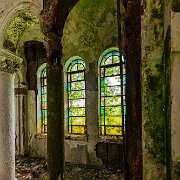
4 Saints Constantine and Helen Greek Orthodox Church in Detroit was born out of the spiritual and cultural needs of a burgeoning Greek immigrant community on the city’s west side. Beginning in the late 1920s with prayer gatherings in a rented Myrtle Street hall, the congregation officially formed in 1930 and worshipped in various makeshift spaces until purchasing land on Oakman Boulevard in 1944. Designed by Arthur Greig Jr., the structure was erected post‑World War II: the cornerstone was laid in 1948, and the first service under its signature partially complete dome took place on Palm Sunday, 1950
A striking example of mid‑20th‑century American Byzantine‑inspired Orthodox architecture, the brick‑and‑stone church features twin domed towers and a central green‐tiled dome that symbolically unites earth and heaven in Orthodox tradition . Interiors would have included classic elements such as an iconostasis separating nave and sanctuary, richly painted icons, and a raised altar area . The community thrived into the 1960s–70s, supporting a school wing and cultural center by 1960, but demographic shifts prompted relocation; by 1986, the parish moved to Westland, where a new sanctuary incorporating the original altar and iconography was completed in 1996
Along its journey from immigrant beginnings to Byzantine‑style landmark, Saints Constantine and Helen has stood as both a spiritual haven and architectural beacon for Detroit’s Greek‑Orthodox faithful.
A striking example of mid‑20th‑century American Byzantine‑inspired Orthodox architecture, the brick‑and‑stone church features twin domed towers and a central green‐tiled dome that symbolically unites earth and heaven in Orthodox tradition . Interiors would have included classic elements such as an iconostasis separating nave and sanctuary, richly painted icons, and a raised altar area . The community thrived into the 1960s–70s, supporting a school wing and cultural center by 1960, but demographic shifts prompted relocation; by 1986, the parish moved to Westland, where a new sanctuary incorporating the original altar and iconography was completed in 1996
Along its journey from immigrant beginnings to Byzantine‑style landmark, Saints Constantine and Helen has stood as both a spiritual haven and architectural beacon for Detroit’s Greek‑Orthodox faithful.
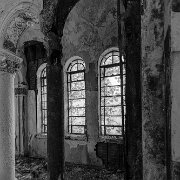
5 Saints Constantine and Helen Greek Orthodox Church in Detroit was born out of the spiritual and cultural needs of a burgeoning Greek immigrant community on the city’s west side. Beginning in the late 1920s with prayer gatherings in a rented Myrtle Street hall, the congregation officially formed in 1930 and worshipped in various makeshift spaces until purchasing land on Oakman Boulevard in 1944. Designed by Arthur Greig Jr., the structure was erected post‑World War II: the cornerstone was laid in 1948, and the first service under its signature partially complete dome took place on Palm Sunday, 1950
A striking example of mid‑20th‑century American Byzantine‑inspired Orthodox architecture, the brick‑and‑stone church features twin domed towers and a central green‐tiled dome that symbolically unites earth and heaven in Orthodox tradition . Interiors would have included classic elements such as an iconostasis separating nave and sanctuary, richly painted icons, and a raised altar area . The community thrived into the 1960s–70s, supporting a school wing and cultural center by 1960, but demographic shifts prompted relocation; by 1986, the parish moved to Westland, where a new sanctuary incorporating the original altar and iconography was completed in 1996
Along its journey from immigrant beginnings to Byzantine‑style landmark, Saints Constantine and Helen has stood as both a spiritual haven and architectural beacon for Detroit’s Greek‑Orthodox faithful.
A striking example of mid‑20th‑century American Byzantine‑inspired Orthodox architecture, the brick‑and‑stone church features twin domed towers and a central green‐tiled dome that symbolically unites earth and heaven in Orthodox tradition . Interiors would have included classic elements such as an iconostasis separating nave and sanctuary, richly painted icons, and a raised altar area . The community thrived into the 1960s–70s, supporting a school wing and cultural center by 1960, but demographic shifts prompted relocation; by 1986, the parish moved to Westland, where a new sanctuary incorporating the original altar and iconography was completed in 1996
Along its journey from immigrant beginnings to Byzantine‑style landmark, Saints Constantine and Helen has stood as both a spiritual haven and architectural beacon for Detroit’s Greek‑Orthodox faithful.
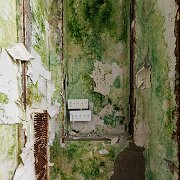
6 Saints Constantine and Helen Greek Orthodox Church in Detroit was born out of the spiritual and cultural needs of a burgeoning Greek immigrant community on the city’s west side. Beginning in the late 1920s with prayer gatherings in a rented Myrtle Street hall, the congregation officially formed in 1930 and worshipped in various makeshift spaces until purchasing land on Oakman Boulevard in 1944. Designed by Arthur Greig Jr., the structure was erected post‑World War II: the cornerstone was laid in 1948, and the first service under its signature partially complete dome took place on Palm Sunday, 1950
A striking example of mid‑20th‑century American Byzantine‑inspired Orthodox architecture, the brick‑and‑stone church features twin domed towers and a central green‐tiled dome that symbolically unites earth and heaven in Orthodox tradition . Interiors would have included classic elements such as an iconostasis separating nave and sanctuary, richly painted icons, and a raised altar area . The community thrived into the 1960s–70s, supporting a school wing and cultural center by 1960, but demographic shifts prompted relocation; by 1986, the parish moved to Westland, where a new sanctuary incorporating the original altar and iconography was completed in 1996
Along its journey from immigrant beginnings to Byzantine‑style landmark, Saints Constantine and Helen has stood as both a spiritual haven and architectural beacon for Detroit’s Greek‑Orthodox faithful.
A striking example of mid‑20th‑century American Byzantine‑inspired Orthodox architecture, the brick‑and‑stone church features twin domed towers and a central green‐tiled dome that symbolically unites earth and heaven in Orthodox tradition . Interiors would have included classic elements such as an iconostasis separating nave and sanctuary, richly painted icons, and a raised altar area . The community thrived into the 1960s–70s, supporting a school wing and cultural center by 1960, but demographic shifts prompted relocation; by 1986, the parish moved to Westland, where a new sanctuary incorporating the original altar and iconography was completed in 1996
Along its journey from immigrant beginnings to Byzantine‑style landmark, Saints Constantine and Helen has stood as both a spiritual haven and architectural beacon for Detroit’s Greek‑Orthodox faithful.
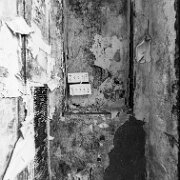
7 Saints Constantine and Helen Greek Orthodox Church in Detroit was born out of the spiritual and cultural needs of a burgeoning Greek immigrant community on the city’s west side. Beginning in the late 1920s with prayer gatherings in a rented Myrtle Street hall, the congregation officially formed in 1930 and worshipped in various makeshift spaces until purchasing land on Oakman Boulevard in 1944. Designed by Arthur Greig Jr., the structure was erected post‑World War II: the cornerstone was laid in 1948, and the first service under its signature partially complete dome took place on Palm Sunday, 1950
A striking example of mid‑20th‑century American Byzantine‑inspired Orthodox architecture, the brick‑and‑stone church features twin domed towers and a central green‐tiled dome that symbolically unites earth and heaven in Orthodox tradition . Interiors would have included classic elements such as an iconostasis separating nave and sanctuary, richly painted icons, and a raised altar area . The community thrived into the 1960s–70s, supporting a school wing and cultural center by 1960, but demographic shifts prompted relocation; by 1986, the parish moved to Westland, where a new sanctuary incorporating the original altar and iconography was completed in 1996
Along its journey from immigrant beginnings to Byzantine‑style landmark, Saints Constantine and Helen has stood as both a spiritual haven and architectural beacon for Detroit’s Greek‑Orthodox faithful.
A striking example of mid‑20th‑century American Byzantine‑inspired Orthodox architecture, the brick‑and‑stone church features twin domed towers and a central green‐tiled dome that symbolically unites earth and heaven in Orthodox tradition . Interiors would have included classic elements such as an iconostasis separating nave and sanctuary, richly painted icons, and a raised altar area . The community thrived into the 1960s–70s, supporting a school wing and cultural center by 1960, but demographic shifts prompted relocation; by 1986, the parish moved to Westland, where a new sanctuary incorporating the original altar and iconography was completed in 1996
Along its journey from immigrant beginnings to Byzantine‑style landmark, Saints Constantine and Helen has stood as both a spiritual haven and architectural beacon for Detroit’s Greek‑Orthodox faithful.
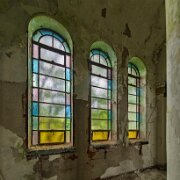
8 Saints Constantine and Helen Greek Orthodox Church in Detroit was born out of the spiritual and cultural needs of a burgeoning Greek immigrant community on the city’s west side. Beginning in the late 1920s with prayer gatherings in a rented Myrtle Street hall, the congregation officially formed in 1930 and worshipped in various makeshift spaces until purchasing land on Oakman Boulevard in 1944. Designed by Arthur Greig Jr., the structure was erected post‑World War II: the cornerstone was laid in 1948, and the first service under its signature partially complete dome took place on Palm Sunday, 1950
A striking example of mid‑20th‑century American Byzantine‑inspired Orthodox architecture, the brick‑and‑stone church features twin domed towers and a central green‐tiled dome that symbolically unites earth and heaven in Orthodox tradition . Interiors would have included classic elements such as an iconostasis separating nave and sanctuary, richly painted icons, and a raised altar area . The community thrived into the 1960s–70s, supporting a school wing and cultural center by 1960, but demographic shifts prompted relocation; by 1986, the parish moved to Westland, where a new sanctuary incorporating the original altar and iconography was completed in 1996
Along its journey from immigrant beginnings to Byzantine‑style landmark, Saints Constantine and Helen has stood as both a spiritual haven and architectural beacon for Detroit’s Greek‑Orthodox faithful.
A striking example of mid‑20th‑century American Byzantine‑inspired Orthodox architecture, the brick‑and‑stone church features twin domed towers and a central green‐tiled dome that symbolically unites earth and heaven in Orthodox tradition . Interiors would have included classic elements such as an iconostasis separating nave and sanctuary, richly painted icons, and a raised altar area . The community thrived into the 1960s–70s, supporting a school wing and cultural center by 1960, but demographic shifts prompted relocation; by 1986, the parish moved to Westland, where a new sanctuary incorporating the original altar and iconography was completed in 1996
Along its journey from immigrant beginnings to Byzantine‑style landmark, Saints Constantine and Helen has stood as both a spiritual haven and architectural beacon for Detroit’s Greek‑Orthodox faithful.
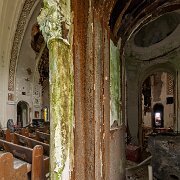
9 Saints Constantine and Helen Greek Orthodox Church in Detroit was born out of the spiritual and cultural needs of a burgeoning Greek immigrant community on the city’s west side. Beginning in the late 1920s with prayer gatherings in a rented Myrtle Street hall, the congregation officially formed in 1930 and worshipped in various makeshift spaces until purchasing land on Oakman Boulevard in 1944. Designed by Arthur Greig Jr., the structure was erected post‑World War II: the cornerstone was laid in 1948, and the first service under its signature partially complete dome took place on Palm Sunday, 1950
A striking example of mid‑20th‑century American Byzantine‑inspired Orthodox architecture, the brick‑and‑stone church features twin domed towers and a central green‐tiled dome that symbolically unites earth and heaven in Orthodox tradition . Interiors would have included classic elements such as an iconostasis separating nave and sanctuary, richly painted icons, and a raised altar area . The community thrived into the 1960s–70s, supporting a school wing and cultural center by 1960, but demographic shifts prompted relocation; by 1986, the parish moved to Westland, where a new sanctuary incorporating the original altar and iconography was completed in 1996
Along its journey from immigrant beginnings to Byzantine‑style landmark, Saints Constantine and Helen has stood as both a spiritual haven and architectural beacon for Detroit’s Greek‑Orthodox faithful.
A striking example of mid‑20th‑century American Byzantine‑inspired Orthodox architecture, the brick‑and‑stone church features twin domed towers and a central green‐tiled dome that symbolically unites earth and heaven in Orthodox tradition . Interiors would have included classic elements such as an iconostasis separating nave and sanctuary, richly painted icons, and a raised altar area . The community thrived into the 1960s–70s, supporting a school wing and cultural center by 1960, but demographic shifts prompted relocation; by 1986, the parish moved to Westland, where a new sanctuary incorporating the original altar and iconography was completed in 1996
Along its journey from immigrant beginnings to Byzantine‑style landmark, Saints Constantine and Helen has stood as both a spiritual haven and architectural beacon for Detroit’s Greek‑Orthodox faithful.
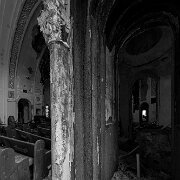
10 Saints Constantine and Helen Greek Orthodox Church in Detroit was born out of the spiritual and cultural needs of a burgeoning Greek immigrant community on the city’s west side. Beginning in the late 1920s with prayer gatherings in a rented Myrtle Street hall, the congregation officially formed in 1930 and worshipped in various makeshift spaces until purchasing land on Oakman Boulevard in 1944. Designed by Arthur Greig Jr., the structure was erected post‑World War II: the cornerstone was laid in 1948, and the first service under its signature partially complete dome took place on Palm Sunday, 1950
A striking example of mid‑20th‑century American Byzantine‑inspired Orthodox architecture, the brick‑and‑stone church features twin domed towers and a central green‐tiled dome that symbolically unites earth and heaven in Orthodox tradition . Interiors would have included classic elements such as an iconostasis separating nave and sanctuary, richly painted icons, and a raised altar area . The community thrived into the 1960s–70s, supporting a school wing and cultural center by 1960, but demographic shifts prompted relocation; by 1986, the parish moved to Westland, where a new sanctuary incorporating the original altar and iconography was completed in 1996
Along its journey from immigrant beginnings to Byzantine‑style landmark, Saints Constantine and Helen has stood as both a spiritual haven and architectural beacon for Detroit’s Greek‑Orthodox faithful.
A striking example of mid‑20th‑century American Byzantine‑inspired Orthodox architecture, the brick‑and‑stone church features twin domed towers and a central green‐tiled dome that symbolically unites earth and heaven in Orthodox tradition . Interiors would have included classic elements such as an iconostasis separating nave and sanctuary, richly painted icons, and a raised altar area . The community thrived into the 1960s–70s, supporting a school wing and cultural center by 1960, but demographic shifts prompted relocation; by 1986, the parish moved to Westland, where a new sanctuary incorporating the original altar and iconography was completed in 1996
Along its journey from immigrant beginnings to Byzantine‑style landmark, Saints Constantine and Helen has stood as both a spiritual haven and architectural beacon for Detroit’s Greek‑Orthodox faithful.
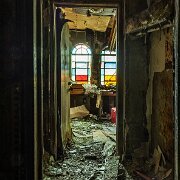
11 Saints Constantine and Helen Greek Orthodox Church in Detroit was born out of the spiritual and cultural needs of a burgeoning Greek immigrant community on the city’s west side. Beginning in the late 1920s with prayer gatherings in a rented Myrtle Street hall, the congregation officially formed in 1930 and worshipped in various makeshift spaces until purchasing land on Oakman Boulevard in 1944. Designed by Arthur Greig Jr., the structure was erected post‑World War II: the cornerstone was laid in 1948, and the first service under its signature partially complete dome took place on Palm Sunday, 1950
A striking example of mid‑20th‑century American Byzantine‑inspired Orthodox architecture, the brick‑and‑stone church features twin domed towers and a central green‐tiled dome that symbolically unites earth and heaven in Orthodox tradition . Interiors would have included classic elements such as an iconostasis separating nave and sanctuary, richly painted icons, and a raised altar area . The community thrived into the 1960s–70s, supporting a school wing and cultural center by 1960, but demographic shifts prompted relocation; by 1986, the parish moved to Westland, where a new sanctuary incorporating the original altar and iconography was completed in 1996
Along its journey from immigrant beginnings to Byzantine‑style landmark, Saints Constantine and Helen has stood as both a spiritual haven and architectural beacon for Detroit’s Greek‑Orthodox faithful.
A striking example of mid‑20th‑century American Byzantine‑inspired Orthodox architecture, the brick‑and‑stone church features twin domed towers and a central green‐tiled dome that symbolically unites earth and heaven in Orthodox tradition . Interiors would have included classic elements such as an iconostasis separating nave and sanctuary, richly painted icons, and a raised altar area . The community thrived into the 1960s–70s, supporting a school wing and cultural center by 1960, but demographic shifts prompted relocation; by 1986, the parish moved to Westland, where a new sanctuary incorporating the original altar and iconography was completed in 1996
Along its journey from immigrant beginnings to Byzantine‑style landmark, Saints Constantine and Helen has stood as both a spiritual haven and architectural beacon for Detroit’s Greek‑Orthodox faithful.
Saints Constantine and Helen Greek Orthodox Church